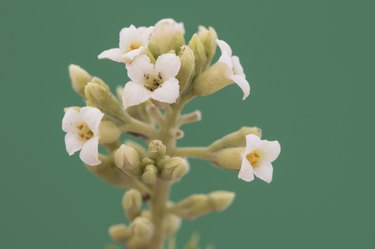
The sweet scent of winter daphne (Daphne odorata), also known as fragrant daphne, wafts across the garden in the drab days of mid to late winter. These winter-flowering bushes thrive in U.S. Department of Agriculture plant hardiness zones 7 through 9. Once established, winter daphne thrives in the landscape, but if it is overwatered or underwatered, it may die abruptly. To add additional daphne shrubs to your landscape or around the foundation of your home, start new plants from cuttings taken in summer.
Daphne Plant Varieties
Video of the Day
While winter daphne is often grown for winter color and its lovely scent, there are approximately 70 to 90 species of these evergreen, semievergreen and deciduous shrubs plus a multitude of hybrids suited to gardens in USDA zones 3 through 9. Native to northern Africa, Asia and Europe, the types of daphne plants range in size from less than 1 foot to 6 feet tall or more and 2 to 4 feet wide depending on the species and cultivar. Most prefer partial shade or filtered sunlight and well-drained locations in the garden.
Video of the Day
Winter daphne grows up to 4 feet tall. While the species plant features narrow, green, evergreen leaves, the cultivar 'Aureo-Marginata' has green leaves edged in pale yellow. Another variegated daphne, 'Carol Mackie' (Daphne x burkwoodii), has wider cream to gold margins on its green leaves and features pink-blushed white flowers in spring and occasionally a second flowering in late summer or fall. At 3 to 4 feet tall and equally wide, 'Carol Mackie' thrives in USDA zones 4 through 9.
Rose daphne (Daphne cneorum) is suited to rock gardens or as a ground cover. At 12 to 18 inches tall and twice as wide, rose daphne is hardy in USDA zones 5 through 9. It also produces pink blossoms in spring. If you have a full-sun or part-sun location in a cool climate, consider planting the 3- to 5-foot-tall and equally wide February daphne (Daphne mezereum), hardy in USDA zones 4 through 7.
Take the Cuttings
Before you begin, put on long sleeves, safety goggles and gloves. All parts of the daphne shrub are toxic if ingested by humans and pets but not wild birds, and the sap is a skin irritant. Keep children and pets away from the cuttings as well as the small fruits that appear after the shrubs finish blooming.
Sterilize your cutting tools by dipping the blades in Lysol and allowing them to air dry. Take cuttings when the shrub is actively growing, generally in summer after flowering. Snip a 4- to 6-inch cutting from new growth. Remove leaves on the lower one-half to two-thirds of the stem and any lingering flowers or fruits.
Plant the Cuttings
Swirl the cut end of the cutting in rooting compound and insert it into moist sand or a mix of equal parts sand and peat moss. Cover the cutting and pot with a plastic bag supported by stakes. Place it in bright filtered light and keep it evenly moist until new roots and foliage develop in one to two months. Transplant it into a larger container until the following year, when it is large enough to transplant outside.
Transplant the Daphne Shrub
Select a well-drained site in partial shade or dappled sunlight. Dig in compost, well-decomposed manure and peat moss in a 3-foot-diameter space around the planting hole. Set the daphne slightly higher in the planting hole than it was in the pot and backfill with the excavated soil. Water thoroughly and add a 2- to 3-inch layer of mulch around the plant.
Keep the soil evenly moist but not waterlogged as the shrub becomes established in the landscape. Apply 1 to 2 inches of water weekly. Fertilize in early spring and midsummer with a slow-release, balanced 10-10-10 fertilizer formulated for acid-loving plants. Trim lightly to shape the shrubs after they bloom and remove all-green leafed branches from variegated plants to prevent them from taking over the shrub.